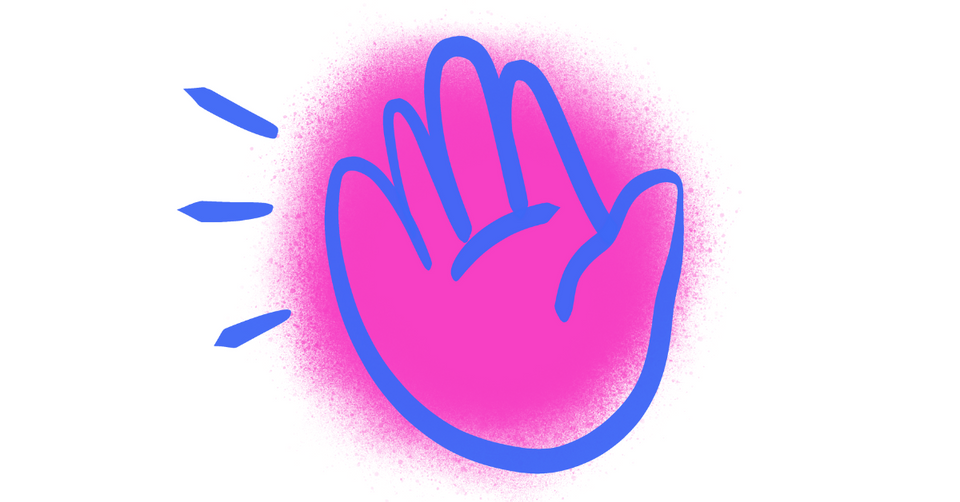Why new mediums matter so much and 5 takeaways from Clubhouse’s rise and (maybe) fall

New mediums, new tools and new platforms can be a huge advantage to the early adopters IF the new medium itself gains traction and grows like crazy.
Think about the early days of blogging and podcasting. The people who jumped in early were the first ones to grow big audiences and many of them are still around. They had to make good content, of course, but when you’re the best option out of not many options, you’re going to crush the market.
In podcasting, Pat Flynn comes to mind. In blogging, Copyblogger was early and grew to be huge. Even YouTube isn’t that old and personalities like Gary V moved early to grow huge audiences and build massive influence.
Clubhouse has blown up and it’s easy to see why people love it (and hate it, but more on that later). Lots of companies and individuals who are making big moves to take advantage of this young platform and I believe there’s still a chance for more people to jump in and carve out a niche of their own.
Recently, Andreesen Horowitz (a16z) decided to become a media company and they’re using Clubhouse to pull in 5,000 people to every single session they host.
NB: As of this writing, Clubhouse limits rooms to max 5000 people.
If you get in early on a new platform and find creative ways to use it before your competitors even know about it, you’ve got a big advantage they can never take away from you.
Don’t chase shiny objects, but...
I’m guilty of finding new tools to play with and doing nothing with them. It’s a huge waste of time.
The mental math I do before diving in to a new platform includes asking myself if there’s a way that I or my team can use this new tool to grow our business. If there’s a way to leverage it for growth, how? And who will it reach? And how will it impact their feelings about our brand?
If there's potential to reach a key audience, then it's time to learn the how the tool works. Often there’s no obvious path to connecting with more people who might buy from us, so we put the tool on the shelf.
How to leverage new tools to gain an advantage over your competition
Guillaume “G” Cabane was the VP of Growth at Drift when I learned about him. In an episode of the Seeking Wisdom podcast, G mentioned that he always looks for new tools to try because if he could find a way to use a new tool before anyone else figured out how it worked, it could be an advantage for Drift.
I love looking at Product Hunt and exploring sites like G2 to find new tools, compare this versus that calendar scheduling tool. Yada yada. Messing around with apps was more fun than anything else, but when I heard G say that tools can be a competitive advantage it changed how I look at products.
Clubhouse is an exciting app and it’s fascinating to sit in on open conversations with total strangers. But how does it impact marketing? How does it change what I can communicate and who I can reach? How can I use it to connect with the right audience?
I think there’s a way to add Clubhouse, Capiche.fm, and other audio-first tools into the marketing mix. It’s not just “podcasting but live”. It’s not “just a conference call” or “Zoom without the video”.
UPDATE: Twitter Spaces, Callin, and Racket (formerly Capiche.fm) are more recent additions to the space. Each one feels like a more mature version of what Clubhouse was hoping to become.
What is Clubhouse and how does it work?
Clubhouse is a simple and easy to pick up and learn quickly.
To help myself and you understand Clubhouse a bit better, here’s a list of what I think IT IS and what IT ISN’T.
- Clubhouse is voice-only. There is one way to communicate in Clubhouse. Your voice. There are zero options to share pictures, share your screen, chat, trade notes, etc. You use your voice and you listen. That’s it.
- Clubhouse is not a podcasting app. Lots of people host shows that sound similar to podcasts, but this is not a syndication tool that let’s you record earlier and share later over and over again. Clubhouse is NOW. It’s more like radio than podcasting.
- Clubhouse is not one-way. Podcasting and radio are one-way communications. The podcasters talk and you listen. There’s not back and forth unless you pick up the phone and call in to a radio show. Podcasts of course don’t have any immediate conversation capabilities with the audience.
- Clubhouse is multi-directional. I was going to type bi-directional, but Clubhouse is so much more than one-to-one. The way the “rooms” work in the app makes it easy for a lot of people to take part in the conversation. You can join any room and within seconds be holding a conversation with the hosts and anyone else they allow to open their mic.
- Clubhouse is moderated. Rooms on Clubhouse have to be started by someone and that person is then the host of the room. He or she has control over who can speak and who can listen. The area of the room where you can speak is called the stage and once you’re invited up you can mute and unmute yourself to speak with the other people on the stage. Both you and the host can move you back to listen only mode.
- Clubhouse is efficient. I can speak a lot faster than I type and Clubhouse conversations feel like a much simpler way of getting a point across while keeping the tone and context you want. Text-based messaging can be so easily misread (ever read a text message from a friend and think he was being a total dickhead, only to find out that he was in a meeting and needed to keep it short?).
- Clubhouse is contextual. So, if using your voice is efficient, it’s also a lot more contextual than text messaging. Your friend, the dickhead with the short SMS above, never meant to sound rude. With voice conversations there’s a lot less room to misinterpret what people are saying and what they mean. You can hear emotions in voices, so you get so much more context from the conversations.
- Clubhouse feels like something you already know. It’s simple conversations. Period. You don’t have to learn how to communicate on Clubhouse like you might have when Twitter was limited to 140 characters. There’s no new way of talking that is going to make you a star on Clubhouse. You talk. You listen. You trade ideas. Done.
- It is not Zoom. Clubhouse rooms can be chaos, but with a good moderator any room can be a fun way to learn. Zoom calls are more like meetings. Clubhouse is more like panel discussion at a conference.
Clubhouse Use Cases you can steal
Side note: use cases are an amazing way to teach people how to use your product. No matter what you sell, if you can show people how your product fits into their workflow, you’ll get more customers.
Back to Clubhouse. After spending a lot of time poking around the app, listening to more strangers than I care to remember, and talking with other users, here's a list of use cases.
- Find and listen to your customers directly. If you can find the rooms where your customers hang out, go listen to how they speak, pick up the lingo and reflect that back to them in your marketing on and off Clubhouse. Yes, this is kind of stalky, but it’s also killer customer research.
- Send people to your Twitter and Instagram accounts. As I write this, Clubhouse only offers two links from your profile. One to Twitter and one to Instagram. Users have reported seeing big spikes in followers on those social networks after speaking on stage in a Clubhouse room. Add your Twitter and Insta profiles to Clubhouse and make it easy for people to follow you.
- Hold office hours for clients and customers. Want to connect with your customers? Why not hold office hours each week at a scheduled day and time? This is way easier than setting up a recurring Zoom call and your customers can get direct access to you and your team.
- Another opportunity to serve people. Similar to office hours, you could run regularly scheduled support calls where people can ask questions and talk through things like use cases or common support queries. This could get awkward if someone decides to have a bitch on an open channel, but there’s probably a way to minimize the risk of that happening.
- Be stalker bait. Huh? If you’re one of the first people to join a room, your profile will be at the top of the list. I’ve seen a lot more activity around my profile when I’m at the top of the listener list and gained heaps of followers on Clubhouse just by being an early listener in a room. If you use Clubhouse like me, you’ll be tapping a lot of profiles to see who people are and what they’re doing on there. Keep showing up and people will find you. For more attention, you could try adding a thumb-stopping profile pic.
- Private Mastermind that you sometimes open to your audience. I saw this work really well for Pat Flynn, Michael Stelzner and other well-known podcasters. Pat and Michael are in a weekly mastermind together. One week, they decided to host their mastermind call live on Clubhouse so us normies could listen in and ask questions. It was a cool way to see them open up and connect with people.
- Build direct connections with people you admire. All Clubhouse users are easy to follow and connect with. This is the first platform I’ve seen where you can follow someone you like and immediately start a conversation with them. You can follow people, but if you’re in a room with them you can also very easily speak with them. If you want to connect with online mentors, Clubhouse is a great way to do that.
- Take the conversation off Clubhouse. Clubhouse conversations can take up huge parts of your day, but they don’t have to. If you get into a conversation and want to continue it later, why not move it to Twitter? It’s easy to connect with people on Clubhouse and follow them on Twitter. You can even do this while listening to a Clubhouse conversation: @ speakers on Twitter as they’re talking and move your conversation to Twitter.
- Stay consistent and be your own radio show host. Like any good content schedule, consistency is probably rewarded on Clubhouse too. Andreesen Horowitz (a16z) started several regularly scheduled calls on Clubhouse and their room is always at max capacity (5,000 people as of this writing). This is like having a radio show. If people know when you’re going live, they’ll schedule time to listen.
- Members-only rooms. Maybe you have paying customers or subscribers you want to give a little something extra. You could host private sessions (like Office hours above) where people get direct, live access to you and your team.
- Host after parties for your live stream events. Say you’re sending a live stream to Facebook, LinkedIn and YouTube at the same time. Even with a moderator and someone to help you run the show, it’s hard to connect with everyone watching. That’s ok because it’s part of the live stream way of working. What if you could host an all audio after party where anyone from the live stream can come and connect with you and other speakers. I love Clubhouse as a post-live event session where you can just hang out and connect with people.
- Use Twitter or LinkedIn for live comments. Clubhouse is audio only and that’s fantastic. Being so simple means Clubhouse can make the audio experience the best it can be. That means no endlessly scrolling chat threads. If you’ve ever been on a live stream and watched these strings of chat conversations scroll by your eyes, you’ve probably snapped back to reality and realized you have no idea what the speaker is talking about anymore. That doesn’t happen with Clubhouse… but you could send people to Twitter to have conversations there if you want to take audience questions without inviting everyone to the stage.
If you were to do this with LinkedIn, you could use the comments section of a post to monitor the chat and take questions. So long as you, the speaker, aren’t the one trying to hold a good conversation and while reading all of the comments, I think this can work. - Like a webinar but audio only. You probably noticed that podcasts are much more freeing than YouTube videos. Audio lets you do a few things at once. You can listen while you drive or mow the lawn or rake the leaves or ignore your kids. That’s the beauty of Clubhouse too. So instead of running the same webinar or online event playbook that everyone else is struggling to make work, why not do an audio panel? Why not try an audio sales pitch for a new course or product? Constraints can make us more creative, so even if your product needs to be seen to be believed there may be a way to incorporate an audio-only session.
- Pre-launch parties. If you have a product launch or big event coming up, you could setup a pre-launch party on Clubhouse to bring people together before the big reveal. Get people excited and frothy. I think if this were well moderated, you could bring a lot of excitement to a launch and connect with your superfans in an intimate way.
Questions I have about Clubhouse
Clubhouse is young and a lot of people are working hard to figure it out. I haven’t spent enough time on it to feel like I totally get it. Here are some bits I’m wondering about.
How can you post recordings? a16z has done it, but I’m not sure how. I imagine this to be another outlet for podcast content, but also for syndicating audio content like a radio show. Could you record a “show” or a Clubhouse session and syndicate it to other Clubhouse hosts to play for their audiences?
What’s the best CTA on Clubhouse? Right now Clubhouse only lets you add a link to Twitter and a link to Instagram. People have to tap your profile to find these and there’s limited space to add a CTA in your description or profile. So, what’s the best way to encourage people to visit you some where else? I bet that listening to good radio hosts and advertisers is the key to learning new techniques for getting people to take action from audio.
You build an audience on Clubhouse, but can you take them with you? YouTubers have a similar problem. You get heaps of people to watch your videos, but most of those people only know you and follow you on YouTube. I still believe that businesses can be made and built better on email lists than any other form of attention. There are a lot of reasons, but owning the list is the big thing. You don’t own your viewers on YouTube or listeners on Clubhouse. They’re only on that platform. So, following the CTA question, what is the best way to bring Clubhouse listeners with you to other mediums?
How often should you reset the room? I grew up listening to Howard Stern. He’s still one of my favorite personalities ever and damn was he a good radio host and interviewer! The man knows how to run a show and how to get people talking about shit they never thought they’d share. Clubhouse hosts could learn a lot from Stern, but one thing in particular bugged me about several Clubhouse rooms I entered.
If the conversation was already going when I entered the room, many hosts will just keep it going and never stop, welcome new listeners, and set the scene. I’ve heard this is called “resetting the room.” A good host will take a minute to tell listeners what they’re talking about, who’s on the stage, and give people just joining the context they need to understand the conversation. Good hosts do this often, but not too much. I wonder if there are best practices for this?
Five takeaways from Clubhouse
- New platforms can scale your message quickly if you're an early adopter.
- Similar to #1, being early to a new platform can be a gigantic advantage for brands if done right.
- Audio-only will always be a foundational way we connect with audiences and mediums like podcasts and some form of radio will be around forever.
- It's easy to look back and say Clubhouse was a failure, but companies like Clubhouse set us on new paths and unlock new ways of connecting that we should all be aware of.
- It's ok to try new things. It's fun exploring other peoples' work and it could be pretty damn rewarding.
The Clubhouse team deserves enormous credit for re-introducing a lot of us to the concept of dialogue and engagement. I spent a lot of time on the app when it launched and enjoyed exploring it and thinking about what it could mean for people and brands. It may not be the last app standing, but it was certainly important that it launched when it did and how it did.



